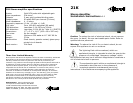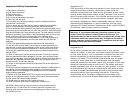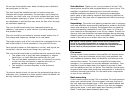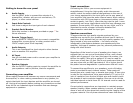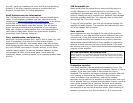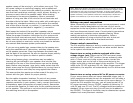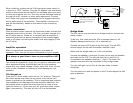
Important Safety Instructions:
1) Read these instructions.
2) Keep these instructions.
3) Read all warnings.
4) Follow all instructions.
5) Do not use this apparatus near water.
6) Clean only with dry cloth.
7) Do not block any ventilation openings. Install in accordance with the
manufacturer’s instructions.
8) Do not install near any heat sources such as radiators, heat registers,
stoves, or other apparatus (including amplifiers) that produce heat.
9) Do not defeat the safety purpose of the polarized or grounding-type plug. A
polarized plug has two blades with one wider than the other. A grounding type
plug has two blades and a third grounding prong. The wide blade or the third
prongs are provided for your safety. If the provided plug does not fit into your
outlet, consult an electrician for replacement of the obsolete outlet.
10) Protect the power cord from being walked on or pinched particularly at
plugs, convenience receptacles, and the point where they exit from the
apparatus.
11) Only use attachments/accessories specified by the manufacturer.
12) Use only with the cart, stand, tripod, bracket, or table specified by the
manufacturer, or sold with the apparatus. When a cart is used, use caution
when moving the cart/apparatus combination to avoid injury from tip-over.
13) Unplug this apparatus during lightning storms or when unused for long
periods of time.
14) Refer all servicing to qualified service personnel. Servicing is required
when the apparatus has been damaged in any way, such as power-supply
cord or plug is damaged, liquid has been spilled or objects have fallen into the
apparatus, the apparatus has been exposed to rain or moisture, does not
operate normally, or has been dropped.
15).Under no circumstances should the output terminals of the amplifier be
short-circuited.
16).Be sure that the loudspeakers connected can handle the output power of
the amplifier at the loudspeakers rated impedance. The warranty on the
amplifier does not cover damage to loudspeakers that have inadequate
power handling capabilities.
17) Where an all-pole MAINS SWITCH is used as the disconnect device, the
location on the apparatus and the function of the switch shall be described,
and the switch shall remain readily operable;
18) A push button is used to turn the power off and on.
19) A LED is used to show when the apparatus is powered on.
CAUTION: These servicing instructions are for use by qualified service
personnel only. To reduce the risk of electric shock do not perform any
servicing other than that contained in the operating instructions unless you
are qualified to do so.
Suggestion #3
Poor grounding of the electrical system in your home may also
cause ground loop problems, particularly when there are
multiple components with three prong, grounded, power cords.
Unplug these components one at a time, and see if one or all of
them is causing the problem. The ultimate solution to this type
of problem is to rewire your house with an isolated, star type-
grounding configuration. Knoll understands that this may be
impractical and expensive. In some instances, the use of an
approved AC Power Isolation Transformer (Knoll model PLB200)
of sufficient capacity may solve this problem.
Warning: If you suspect that the grounding system in your
home’s electrical wiring is causing the hum problem, it is
important that you do not make any changes to the wiring. Only
a licensed electrician should make any changes to household
wiring, and they must be made in full compliance with all local
building, safety and electrical codes.
Suggestion #4
Faulty earth grounds may also cause hum in your home’s
electrical system. In the past, cold water pipes were often used
for the earth ground, so it is important to make sure that your
ground connection is working properly and has not become
loose or corroded. The cold water pipe method may no longer
be valid in some areas due to requirements that the water
meter be isolated for the water mains with a length of PVC pipe,
therefore interrupting the ground circuit. The safest and most
reliable approach may be to provide your own ground. This can
be accomplished by having a licensed electrician drive at least
five feet of copper-jacketed steel grounding rod into the earth,
and using that for your grounding connection. If the hum
persists after all of the above suggestions have been tried,
contact Knoll’s Technical Support department for assistance.



